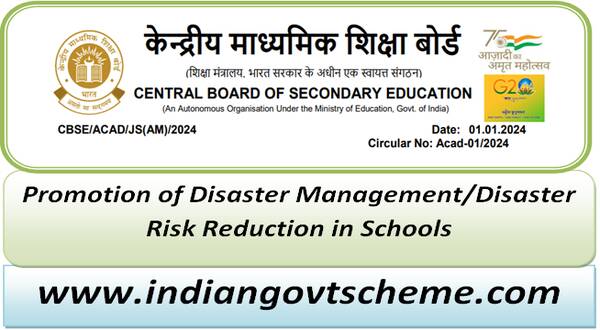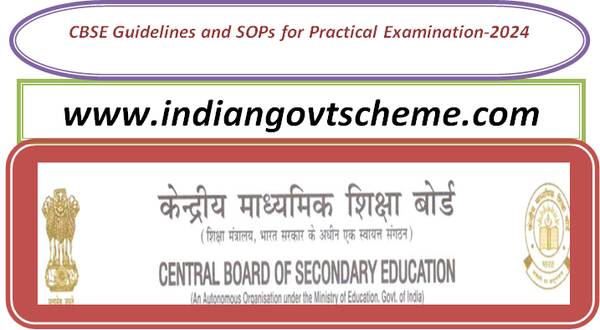Promotion of Disaster Management/Disaster Risk Reduction in Schools : CBSE introduces Disaster Risk Reduction (DRR) in the curriculum to educate students on disaster concepts, mitigation, and preparedness. Guidelines for teachers aim to integrate DRR across subjects for comprehensive learning
CBSE/ACAD/JS(AM)/2024
Date: 01.01.2024
Circular No: Acad-01/2024
All the Heads of Schools affiliated to CBSE
Subject: Promotion of Disaster Management/Disaster Risk Reduction in Schools – reg.
Dear Principal, Greetings from CBSE !
As you are aware that the Disaster Management course of the Central Board of Secondary Education aims to educate students about the concept of disasters, their causes, mitigation measures and develop an awareness towards reducing the occurrence of disasters. Though Disaster Management has been a part of the CBSE curriculum since many years, the need of the hour is to integrate the latest concept of Disaster Risk Reduction (DRR) with different subjects in the curriculum.

DRR has gained prominence globally, and integrating it into the school curriculum will foster a greater understanding of the environment, risks involved with disasters, and the need for preparedness and resilience among students and teachers. The DRR course will focus on equipping students with the skills to develop emergency response plans, put together emergency supply kits, and conduct drills and simulations. Disasters have a strong impact on an individual’s emotions, so the course will emphasize coping mechanisms and approaches to face adversities.
Another objective of this course is to encourage a sense of civic responsibility and inspire students to contribute to their communities’ disaster preparedness and response efforts. The course also aims to prepare young students to face life’s risks by training them to use their critical thinking and decision-making skills to avert disasters and understand the consequences of their actions. Additionally, the course is designed to ensure students are aware of environment-friendly measures that reduce vulnerability to hazards. An effective DRR is more about reducing the risk of a disaster than just about managing a disaster.
The purpose of integrating DRR with subjects in the school curriculum is to foster the all- inclusive approach. Here, the students will apply their understanding of the content-knowledge of the subject to help them develop necessary skills to manage disasters in their community. The activities integrated with the subjects will provide an opportunity for the students to think critically, work collaboratively and hone their communication skills.
Finally, the DRR course aims to empower students with the knowledge, skills and attitudes essential for reducing the risks posed by disasters and contributing to building safer and more resilient communities.
CBSE has developed the Guidelines for Teachers on Disaster Risk Reduction in Schools. This is a step towards involving all teachers in the school, irrespective of the subjects they teach, in the urgent task of guiding their students to prevent disasters and protect them during emergencies. These guidelines identify class-wise and subject-wise topics in the NCERT textbooks prescribed for affiliated schools, which can be used by subject teachers to create awareness about Disaster Risk Reduction in their classrooms. Activity based sample lesson plans covering 5 to 6 chapters from each of the 5 main subjects (English, Hindi, Maths, Science and Social Science) of Classes 6 – 10 has been created to link the lessons to Disaster Risk Reduction topics. Teachers may follow the suggested lesson plans or develop their own teaching-learning strategies suitable for their students. Classroom discussions on Disaster Risk Reduction should be conducted with a positive approach, helping students develop practical confidence to deal with hazardous situations.
This interdisciplinary approach will help students develop a holistic understanding of disaster management. For example, in science classes, teachers can discuss natural disasters and their scientific causes, while in social studies, they can explore the socio-economic impacts of disasters. Every subject teacher should allot at least one period per class per month in her regular timetable to teach a lesson by relating it to a topic of Disaster Risk Reduction in school. Principals are requested to ensure its implementation in your respective schools.
It is expected that if all teachers follow these guidelines on Disaster Risk Reduction in Schools, it will help students:
- Learn about Disaster Risk Reduction principles and actively participate in DRR practices taught in school and outside.
- Take note of disaster risks in their own locality and actively seek solutions to prevent and reduce their impact.
- Prepare and implement the School Safety Plan by participating in mock drills and appropriate response strategies available in the school and community.
- Spread the knowledge on DRR acquired in school to their families and communities.
All schools are requested to download the Guidelines for Teachers on Disaster Risk Reduction in Schools (Classes 6 to 10) available in the Board’s website and incorporate it in their regular classroom teaching and learning.
With Best Wishes
Dr Joseph Emmanuel
Director (Academics)
Copy to the respective Heads of Directorates, Organizations and Institutions as indicated below with a request to disseminate the information to all the schools under their jurisdiction:
1. The Commissioner, Kendriya Vidyalaya Sangathan, 18 Institutional Area, Shaheed Jeet Singh Marg, New Delhi-16
2. The Commissioner, Navodaya Vidyalaya Samiti, B-15, Sector-62, Institutional Area, Noida-201309
3. The Secretary, Eklavya Model Residential Schools (EMRS), Ministry of Tribal Affairs, Government of India.
4. The Secretary, Sainik Schools Society, Room No. 101, D-1 Wing, Sena Bhawan, NewDelhi- 110001.
5. The Chairman, Odisha Adarsha Vidyalaya Sangathan, N-1/9, Near Doordarshan Kendra, PO Sainik School Nayapalli, Bhubaneswar, Odhisha-751005.
6. The Director of Education, Directorate of Education, Govt. of NCT of Delhi, OldSecretariat, Delhi-110 054
7. The Director of Public Instructions (Schools), Union Territory Secretariat, Sector 9, Chandigarh-160017
8. The Director of Education, Govt. of Sikkim, Gangtok, Sikkim –737101
9. The Director of School Education, Govt. of Arunachal Pradesh, Itanagar –791 111
10. The Director of Education, Govt. of A&N Islands, Port Blair – 744101
11. The Director of Education, S.I.E., CBSE Cell, VIP Road, Junglee Ghat, P.O. 744103,A&N Island
12. The Director, Central Tibetan School Administration, ESSESS Plaza, CommunityCentre, Sector -3, Rohini, Delhi
13. The Additional Director General of Army Education, A –Wing, Sena Bhawan, DHQ, PO,New Delhi-110001
14. The Secretary AWES, Integrated Headquarters of MoD (Army), FDRC Building No. 202, Shankar Vihar (Near APS), Delhi Cantt-110010
15. All Regional Directors/Regional Officers of CBSE with the request to send this circularto all the Heads of the affiliated schools of the Board in their respective regions
16. All Joint Secretary/ Deputy Secretary/ Assistant Secretary/SPS / Analyst, CBSE
17. All Head(s)/ In-Charge(s), Centre of Excellence, CBSE
18. In charge IT Unit with the request to put this Circular on the CBSE Academic Website
19. In-Charge, Library
20. The Head (Media & Public Relations), CBSE
21. DS to Chairperson, CBSE
22. SPS to Secretary, CBSE
23. SPS to Director (Academics), CBSE
24. SPS to Director (Information Technology), CBSE
25. SPS to Controller of Examinations, CBSE
26. SPS to Director (Skill Education), CBSE
27. SPS to Director (Professional Examinations), CBSE
28. SPS to Director (Training), CBSE
29. SPS to Director (CTET), CBSE
30. SPS to Director (EDUSAT), CBSE
31. Record File
Director (Academics)
नोट :- हमारे वेबसाइट www.indiangovtscheme.com पर ऐसी जानकारी रोजाना आती रहती है, तो आप ऐसी ही सरकारी योजनाओं की जानकारी पाने के लिए हमारे वेबसाइट www.indiangovtscheme.com से जुड़े रहे।

